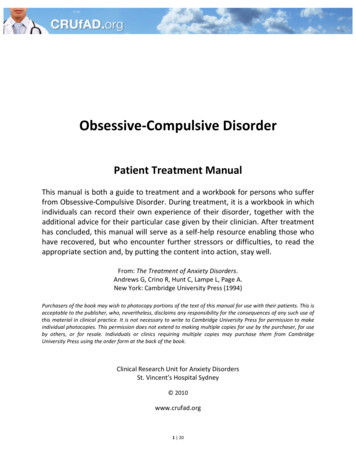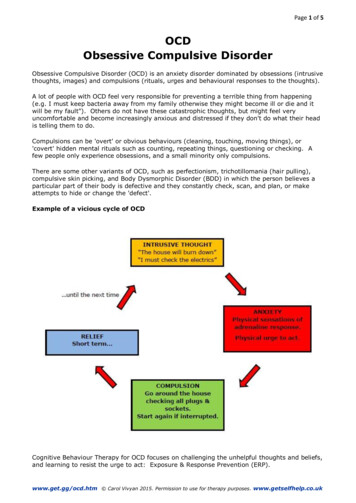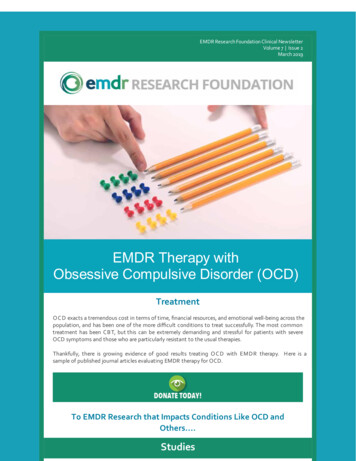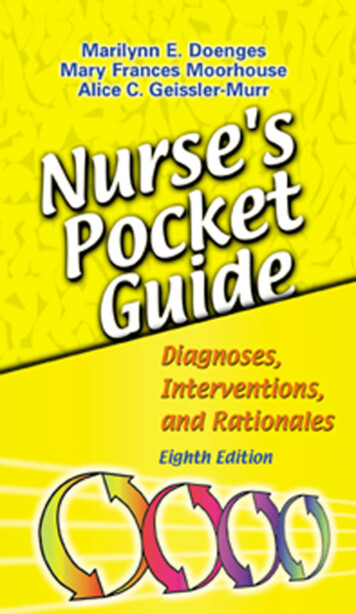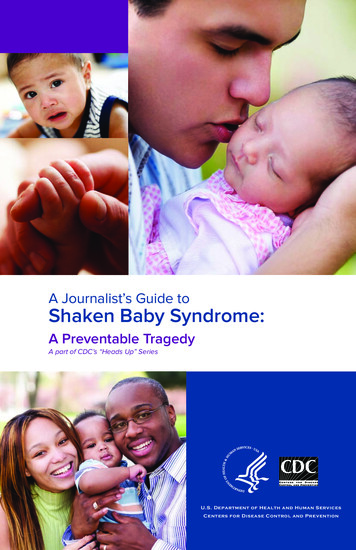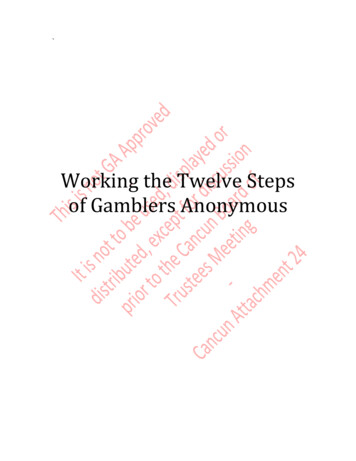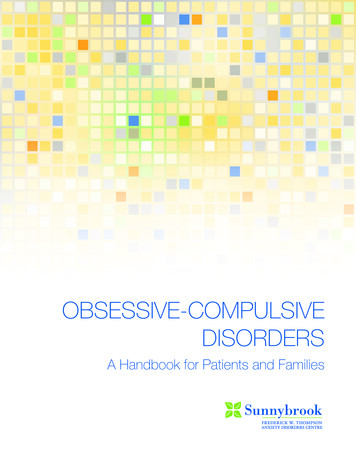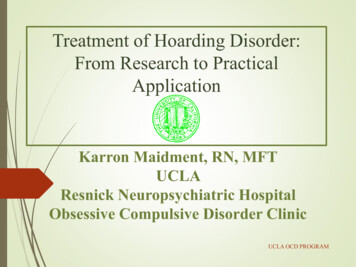
Transcription
Treatment of Hoarding Disorder:From Research to PracticalApplicationKarron Maidment, RN, MFTUCLAResnick Neuropsychiatric HospitalObsessive Compulsive Disorder ClinicUCLA OCD PROGRAM
Hoarding Disorder Definition Current research Treatment and ManagementUCLA OCD PROGRAM
Hoarding BehaviorHoarding Behavior should be distinguishedfrom Hoarding Disorder: Dementia Psychosis Eating Disorders Major Depression Normal populationPeople with Clinically Significant HoardingBehaviors Need Diagnostic EvaluationUCLA OCD PROGRAM
Hoarding DisorderUCLA OCD PROGRAM
Hoarding Disorder –Clinical Criteria Persistent difficulty discarding or parting with possessionsregardless of their actual value. This difficulty is due to a perceived need to save the items, and todistress associated with discarding them. The difficulty discarding possessions results in the accumulationof possessions that congest and clutter active living areas andsubstantially compromise their intended use. The hoarding causes clinically significant distress or impairmentin functioning.DSM -5 American Psychiatric Association 2013UCLA OCD PROGRAM
Hoarding DisorderMost commonly hoarded items:NewspapersMagazinesBagsBooksMailNotes and ListsStorage ContainersOld ClothesMemorabilia(Frost & Gross, 1993; Winsberg et al, 1999)UCLA OCD PROGRAM
Research –3 Perspectives Cognitive Behavioral Neurobiology NeurocognitiveUCLA OCD PROGRAM
Cognitive BehavioralUCLA OCD PROGRAM
Hoarding Disorder –a Cognitive Behavioral ModelHoarding is part of a discrete clinical syndrome that includes; Indecisiveness Perfectionism Difficulty with organizing AvoidanceUCLA OCD PROGRAM
Indecisiveness Compulsive Hoarders have difficulty makingdecisions about everything, not just saving items. Excessive concern with making a mistake.Frost and Hartl ‘96, Grisham et al 2010UCLA OCD PROGRAM
IndecisivenessCompulsive hoarders have an overlycomplex way of thinking. This makesdecision making time consuming andonerous.Ayers et al 2013. Grisham et al 2010UCLA OCD PROGRAM
IndecisivenessSaving allows the person withhoarding to avoid the decisionrequired when discarding apossession, and thus avoid theworry about making a mistake bythrowing something away.Frost and Gross 1993UCLA OCD PROGRAM
Hoarding Disorder –a Cognitive Behavioral ModelHoarding is part of a discrete clinical syndrome that includes; Indecisiveness Perfectionism Difficulty with organizing AvoidanceUCLA OCD PROGRAM
Perfection Every activity has to be done perfectly. Need to remember everything, perfectly. Possessions are perfect and thereforeirreplaceableFrost and Steketee 1999. Frost and Gross 1993UCLA OCD PROGRAM
Perfection Fear of making a mistake Serious negative consequences will resultfrom forgetting All or nothingHartl and Frost, 2004UCLA OCD PROGRAM
Hoarding Disorder –a Cognitive Behavioral ModelHoarding is part of a discrete clinical syndrome that includes; Indecisiveness Perfectionism Difficulty with organizing AvoidanceUCLA OCD PROGRAM
OrganizationalProblemsCategorization“Because each possession is so unique, it can not becategorized with similar objects, and thus there isno way to organize possessions”Frost & Hartl, 1996UCLA OCD PROGRAM
Organizational ProblemsThe apparent chaos isnot a reflection oflack of organizingcategories, but rathertoo many.Frost and Hartl 1996UCLA OCD PROGRAM
OrganizationalProblems‘Churning’ occurs when a decision cannot be made about aunique item. It will be ‘put to one side for now.’ This resultsin piles of clutter.Frost and Hartl 1996UCLA OCD PROGRAM
OrganizationalProblemsVisual Cues The sight of a possession will increase its value. Thus, importantobjects are saved along with unimportant objects because everything‘looks’ important. Fear of filing something away for fear of forgetting the file headingFrost and Hartl 1996UCLA OCD PROGRAM
Hoarding Disorder –a Cognitive Behavioral ModelHoarding is part of a discrete clinical syndrome that includes; Indecisiveness Perfectionism Difficulty with organizing AvoidanceUCLA OCD PROGRAM
AvoidanceHoarding is anavoidancebehavior tied toindecisiveness andperfectionismFrost and Gross 1993UCLA OCD PROGRAM
AvoidanceParalysis thru’ analysisAll or nothing behaviorUCLA OCD PROGRAM
Hoarding Disorder –a Cognitive Behavioral Model Emotional attachment problems Erroneous beliefs about the nature of possessionsFrost and Steketee 1999UCLA OCD PROGRAM
NeurobiologyUCLA OCD PROGRAM
Functional Neuroanatomy ofHoarding DisorderBrain Regions with Lower Glucose Metabolismin Hoarding Disorder than in ControlsSagittalLTransverseR3.0Z value2.52.01.51.00.50.0Right PosteriorCingulate GyrusSaxena et al, 2004Am J PsychiatryUCLA OCD PROGRAM
Functional Neuroanatomy ofCompulsive Hoarding SyndromeBrain Regions with Lower Glucose Metabolism in Hoardersthan Non-Hoarding rse3.0R2.5Zvalue2.01.51.00.5(Saxena, Brody, Maidment et al, 2004Am J Psychiatry)0.0UCLA OCD PROGRAM
Role of the Cingulate Cortex Attention, Cognition, and Decision-Making Functions of the dorsal anterior cingulate cortex: attention,motivation, executive control (planning, time sequencing,etc.), assigning emotional valence, error detection, andresponse selection, especially choosing between multipleconflicting options. Functions of the posterior cingulate cortex: episodicmemory, monitoring visual events, spatial orientation, andprocessing of emotional stimuli. (Saxena, Brody, Maidment et al, 2004)UCLA OCD PROGRAM
Role of the Cingulate Cortex Attention, Cognition, and Decision-MakingSummaryDysfunction of the cingulate cortex could mediatethe remarkable decision-making and attentionaldifficulties seen in patients with HoardingDisorder(Saxena, Brody, Maidment et al, 2004)UCLA OCD PROGRAM
Neuro CognitiveUCLA OCD PROGRAM
Compulsive Hoarders haveproblems with .Executive FunctionsNecessary for goal directed behavior. Ability to initiate and stop actions. Monitor and change behavior as needed. Plan future behavior when faced with noveltasks and situations.Encyclopedia of Mental DisordersUCLA OCD PROGRAM
Problem Solving“Executive functions allow us to anticipate outcomesand adapt to changing situations.”UCLA OCD PROGRAM
Compulsive Hoarders haveproblems with . Abstract concepts Problem solving Planning Learning new information Maintaining new skillsMcMillan et al 2012.Grisham et al 2007.Mackin et al 2011. Ayers et al 2013UCLA OCD PROGRAM
Treatment for Hoarding Disorder Cognitive Behavioral NeurobiologyTreatment NeurocognitiveUCLA OCD PROGRAM
Treatment for HoardingDisorderA multi model approach is essential to the effectivetreatment of Hoarding Disorder; Therapist for CBT Psychiatrist for meds Professional organizer specializing in clutter, equivalent helper Adult Protective Services for health, safety, referrals Code Enforcement for health and safety Advocacy agency for financial advice/assistance General Practitioner for medical problems Family for supportUCLA OCD PROGRAM
Treatment Environment In Home In outpatient office with in-home support In Intensive Outpatient ClinicUCLA OCD PROGRAM
Treatment of CompulsiveHoarding Discarding Organizing Prevent IncomingstuffSelf Introduce Alternative BehaviorsUCLA OCD PROGRAM
Discarding ProcessGround rules: Pick a room, any room Very systematic Can’t put stuff‘to one side right now’ Homework daily, time limitedDecision makingOrganizingDecision makingInitiating/stoppingUCLA OCD PROGRAM
Discarding Process Pick a room any room Before photosUCLA OCD PROGRAM
Discarding ProcessGround Rules Take the first item that comes to hand Make a decisiona) Recycleb) Discardc) Keep Final decision is always with the patient Helper does not touch patient’s stuff withoutpermissionUCLA OCD PROGRAM
Discarding ProcessRecycle One recycle option only Cannot recycle to save the world K.I.S.(S)UCLA OCD PROGRAM
Discarding ProcessKeep Put saved item in its correct place immediately Don’t put ‘to one side for now’ If saved items turn up back in ‘sorting’ pile, theymust be discardedUCLA OCD PROGRAM
Discarding - Rationale Forces decision making. Reinforces concept of prioritizing - keeping onlythose things that are important. Acknowledges that some things are not important.UCLA OCD PROGRAM
Discarding - RationaleAddresses executive functioning: A goal directed behavior. A process that involves initiating andstopping. Introduces a different way of doingsomething. Prevents future negative consequencesUCLAOCDPROGRAM
Additional Benefits of discardingclutter Cleared, functional space. Daily visual reminder of accomplishment. Less pressure from friends, family, outside agencies. Opportunity to organize remaining stuff. Opportunity to develop skills to maintain cleared areas.UCLA OCD PROGRAM
Results of Discarding ProcessProsNot so pros Improved decisionmaking aboutdiscarding clutter. Little likelihood ofbeing able to discardalone. Improved decisionmaking about theacquisition ofclutter. Decision makingdoes not generalizewell to other areas oflife.UCLA OCD PROGRAM
Improving Organizational SkillsOrganizing Stuff Create and implement efficient system for filing andstoring items that does not rely on visual cues ormemory.UCLA OCD PROGRAM
Improving Organizational SkillsOrganizing Stuff Stay with the system. Everything is put in its proper place. Don’t leave things out as a reminder Prevent over - categorizationUCLA OCD PROGRAM
Improving Organizational SkillsCleared areas must stay clear. Establish routine for regular ‘sweeps’ of clearedareas.- goal directed, time limited- monitor behavior - make necessarychangesUCLA OCD PROGRAM
Improving Organizational SkillsOrganizing SelfEstablish times for routine ADL’sThe foundation on which to build the rest of the dayUCLA OCD PROGRAM
Improving Organizational SkillsBaseline Routine Activities: Personal hygiene daily Empty trash daily Do dishes daily Sort mail daily Laundry x 1 per week Bills x 1 per weekUCLA OCD PROGRAM
Improving Organizational SkillsIncorporate structure and routine into the day Establish ‘baseline’ routine activities Incorporate recreational time into each day Plan long term structure, e.g. work, school,volunteering, day care.UCLA OCD PROGRAM
Improving Organizational SkillsOrganizing Self Use a calendar- preferably digitalplan day prioritize activitiesmonitor behavior adapt behaviorUCLA OCD PROGRAM
Improving Organizational SkillsProblem solvingEstablish goalPrioritizingCome up with a planOrganizing/PrioritizingBreak it downInitiatingKeep it time limitedStoppingUCLA OCD PROGRAM
Results of ImprovedOrganizational Skills Reduced time for hoarding behavior. Improved sleep, mood, energy. Improved efficiency /functionality Improved general decision making. Improved problem solving.UCLA OCD PROGRAM
Treatment can addressneurocognitive deficitsAbstract conceptsFocus on behavioral. Minimize cognitive.Learning new information / Maintaining new skillsA lot of repetition. Keep tasks small, concrete and time limited.UCLA OCD PROGRAM
Understanding and TreatingCompulsive Hoarding SyndromeRememberHoarding Disorder is a Neuropsychiatric Disorder.- It is not laziness or a character flaw.- It is due to distinct brain abnormalities.- It will not improve without treatment.- Simply throwing away or organizing a hoarder’spossessions will not solve their problems.(Saxena et al, 2004)UCLA OCD PROGRAM
The EndUCLA OCD PROGRAM
Books Mail Notes and Lists Storage Containers Old Clothes Memorabilia (Frost & Gross, 1993; Winsberg et al, 1999) Research – 3 Perspectives Cognitive Behavioral Neurobiology Neurocognitive UCL
